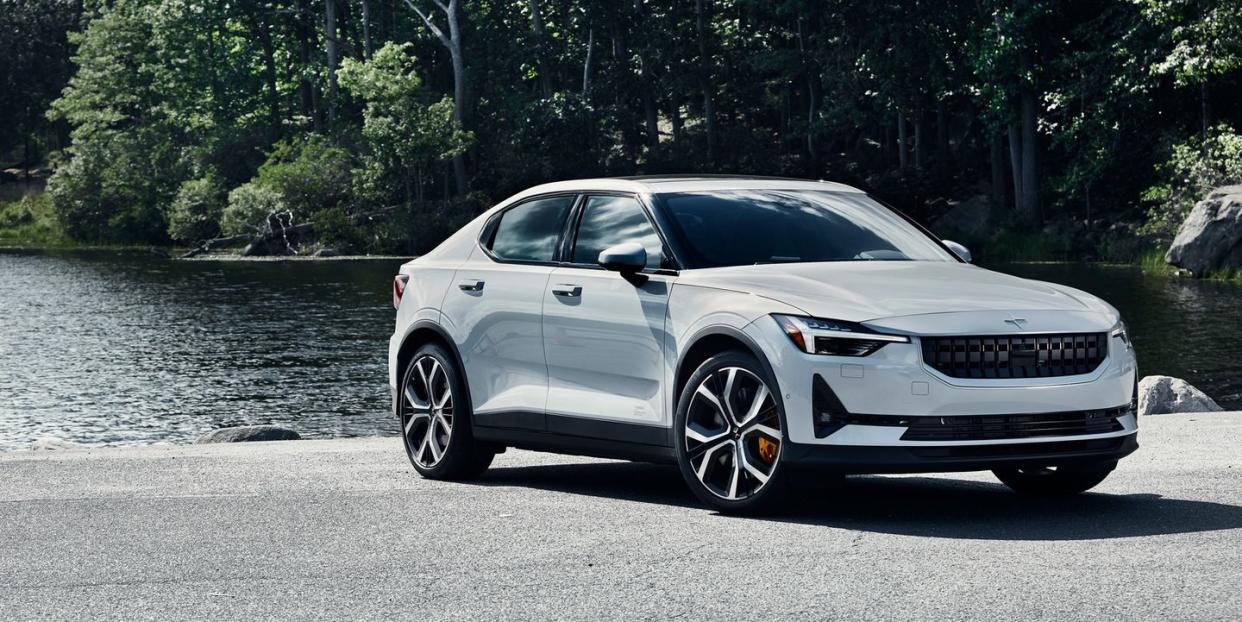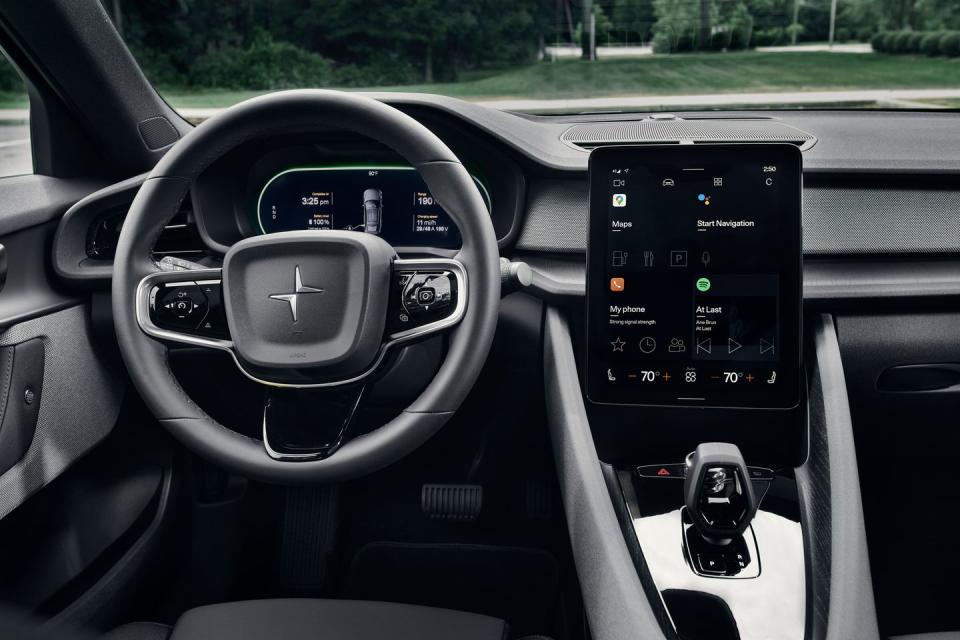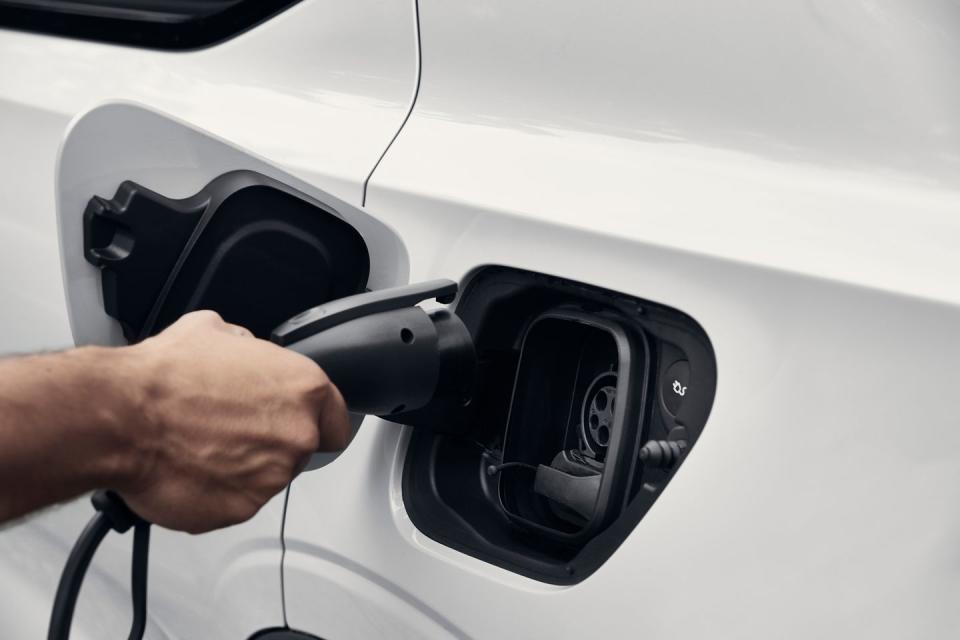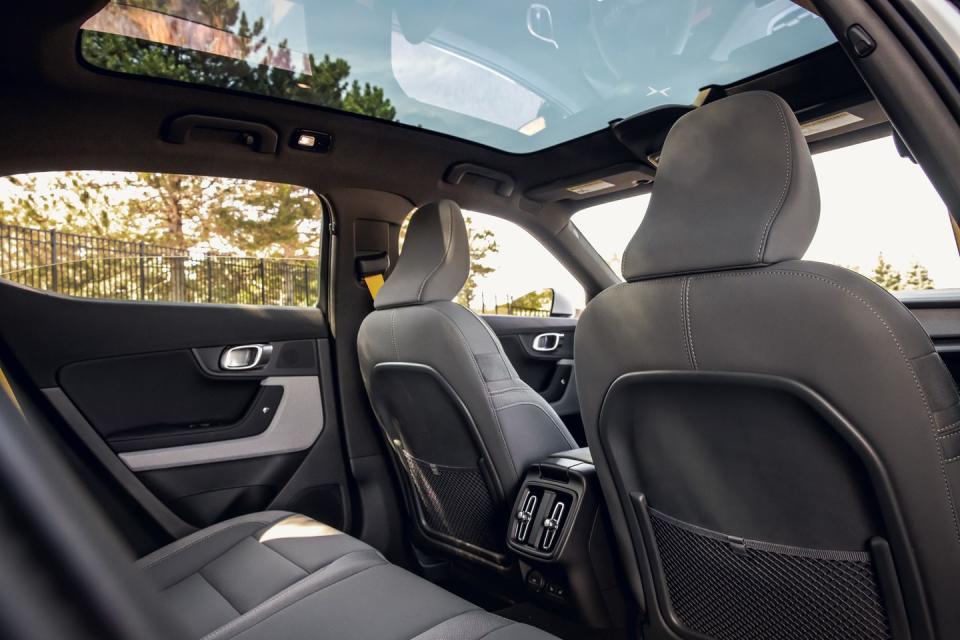The 2022 Polestar 2 Features a Reasonable Price, Cozy Interior, and Clever Suspension Design

The Takeaway
The 2022 model year brings in a new single-motor variant and updated dual-motor Polestar 2, which offers up excellent build quality and performance at a competitive price point—as little as $34,900 with incentives. While neither spec can match the 0-60 times of Tesla’s vehicles, the new lineup is a more complete package, sporting a cozy interior, clever suspension design, and near-perfect weight distribution.
Polestar’s one-pedal driving regenerative braking system eliminates the need to use the brake pedal in most situations.
The interior is dead silent, with no squeaks or rattles to report from the pre-production press cars.
Android Automotive OS paired with the massive 11.3-inch infotainment screen features voice control.
Thanks to its flatter roofline and fastback design, rear passengers have plenty of headroom.
Specs (Single Motor)
Base Price: $45,900 (~$35,000 with incentives)
Range: 265 miles (unofficial Polestar estimate)
Horsepower: 231 hp
Torque: 243 lb-ft
Zero to 60: 7 seconds
Battery Capacity: 78 kWh (limited to 75 kWh)
Charge time (11kW home box, zero to 100%): 8 hours
Charge time (public 150kW DC fast charger 10% to 80%): 33 minutes
Specs (Dual Motor)
Base Price: $49,900 (~$40,000 with incentives)
Range: 249 miles
Horsepower: 408 hp
Torque: 487 lb-ft
Zero to 60: 4.45 seconds
Battery Capacity: 78 kWh (limited to 75 kWh)
Charge time (11kW home box, zero to 100%): 8 hours
Charge time (public 150kW DC fast charger 10% to 80%): 33 minutes
What’s In A Name?
In 2017, Polestar evolved from a Volvo performance division to being a bespoke automotive startup with its Polestar 1, a performance-oriented hybrid. Using the joint power from its turbocharged and supercharged 2.0-liter inline-four engine, supported by three electric motors—one in the front and two in the back—the vehicle developed 619 horsepower and 739 pound-feet of torque. Limited to a production run of just 1,500 units, the inaugural runabout sported a carbon-fiber body and the longest range of any plug-in hybrid—an accolade that it maintains to this day. Despite its monolithic performance figures, the final product was a gentle giant on the road and an absolute weapon on the track.
While the Polestar handle references the north star as a “guiding light” for mariners and the like, the brand aims to use its engineering and design acumen to steer the automotive industry toward a brighter and more sustainable future. Owned by Volvo and Geely Automotive Group, the young outfit may be a relatively new player in the EV game but shares an engineering alliance with its Scandanavian parent company. This access to reach into Volvo’s parts bin (Polestar 2 is based on the existing Volvo CMA platform) allows Polestar to expedite the design, development, and manufacturing processes, which are often fraught with legal difficulties and red tape.
Polestar invited me to Santa Fe, New Mexico, to hop behind the wheel of its latest Polestar 2 Long Range vehicles. If you opt for one, you’ll have two flavors to choose from: single motor and dual motor. My day began driving the dual-motor variant through a pre-determined out-and-back route, which took me through the twisties of Highway 475 up to the Santa Fe Ski Basin at 10,350 feet. After a brief lunch, it was straight into the new single-motor with a more relaxed 86 miles on tap, cruising through the Jemez Mountains up to the Los Alamos History Museum.
Driving (Dual Motor)
Unlike with most EVs, which are focused on maximum efficiency, Polestar says its latest model seeks to not just stand out in the electric space but also be a fantastic driver’s car. That’s a bold claim for any manufacturer to make for any vehicle, but especially a hefty EV that tips the scales at 4,658 pounds—the single-motor is no featherweight either, at 4,396 pounds. However, the dual-motor’s agility through the corners took me immediately by surprise.
This get-up-and-go was enhanced by the optional Performance Package. If you choose the dual-motor option, an additional $5,000 will give you adjustable Öhlins suspension (front and rear), forged 20-inch alloy wheels, Brembo brakes, Continental Sport Contact 6 tires, and Polestar’s “Swedish Gold” aesthetic details—trust me, the yellow seatbelt is cooler than you think.
While most car companies in the EV space are caught up in the perpetual arms race of 0-60 times, the Polestar 2 actually knows what to do when it approaches a corner. And braking is a clear party piece of this car. Even after I carried a bit too much speed into some of the tighter switchbacks of Highway 475, the combined stopping power of the regenerative braking system and Brembo brakes allowed for hilarious point-and-squirt driving. The ABS calibration was excellent, letting me stamp on the brake pedal with little electronic interference.
During the initial presentation, the team made the claim that this setup effectively “negates” mid-corner understeer. While this is true at relatively pedestrian speeds, you can definitely feel the front axle begin to give up if you push hard enough. However, understeer isn’t necessarily a bad thing for a road car; it’s much safer and confidence-inspiring than a car that consistently kicks its tail out.
Regardless of which spec you choose, both vehicles reap the rewards of staggered wheel sizes—eight inches in the front and nine in the rear. Paired with the same size tire at all four corners, this setup stretches the tire, giving you a stiffer sidewall in the rear, offering up improved performance and stability. While this layout is traditionally reserved for cars that are rear-wheel drive only, it allows the latest Polestar 2 to achieve .90G on the skidpad.
Driving (Single Motor)
After an exhilarating drive behind the wheel of the dual-motor Polestar 2 in the morning, I also had the opportunity to drive the single-motor variant in the afternoon. The longer route and subdued powertrain were conducive to exploring other aspects of the vehicle that you’d experience during everyday driving.

The first thing I noticed was the regenerative braking system. Referred to by Polestar as “One-Pedal Driving,” it almost eliminates the need to use the brake pedal. As the system translates rotational energy into electricity, it will slow the vehicle down when you let off the accelerator—think of it as futuristic engine braking. For EV newbies, who might be turned away by the idea, the infotainment screen allows you to limit the strength of the regen or even turn it off altogether.
After experiencing the sublime Öhlins suspension system in the dual motor, I was disappointed with the standard setup in the single. While it’s hard to compare them back to back on different routes, the factory springs and dampers were quite harsh over some of the bumpy roads surrounding the Jemez Mountains.
If you can get over the ride quality, the base single motor is a fantastic entry point into the EV space. It has more than enough power to inspire confidence while merging onto the highway and shooting gaps around the city. And it starts at just $45,900 (approximately $35,000 with incentives); you’ll be hard-pressed to find a better car across the market at that price point.
Range, Speed, and Charging
The dual-motor variant of the Polestar 2 receives mild improvements in the range department with an EPA estimated figure of 249 miles—the new single-motor car can manage 265 miles. Owners of the 2021 Polestar 2 will be able to achieve the latest dual-motor figure with an over-the-air update. While these range figures might sound lackluster in comparison to other vehicles in its class, it’s important to note that the average American only drives less than 30 miles a day.
Despite the Swedish automaker’s claim of its latest EV seeking to be a driver’s car, I’m happy to say that it’s still just as neck-snapping as you’d expect when you put your foot down. While the dual-motor powertrain remains largely unchanged going into 2022, the single-motor layout uses shorter gearing at the front axle (10.51:1 in favor of 8.57:1) to optimize power delivery. Without getting into specifics, lower (taller) gear ratios offer up higher top speed while higher (shorter) ratios offer improved acceleration. Two motors will always be better than one, but the stripped-down layout provides adequate acceleration for everyday driving.
In stark contrast, the dual-motor powertrain is different gravy when you give it the beans. Most cars that I’ve driven provide a gradual sense of gaining speed after you accelerate hard. However, the near-instant acceleration that you get from the Polestar 2 simply catapults you to any (road-legal) speed you desire. This otherworldly punch never failed to put a smile on my face while scything through the mountains of Santa Fe.

Polestar 2 uses a CCS charge port, promising a 10-80 percent charge time of just 33 minutes using a 150-kW fast-charging station. It’s no surprise that Tesla currently sets the benchmark when it comes to charging infrastructure, but home charging gets you around this issue. With its 11-kW onboard charger hooked up to a 240-volt AC power outlet, the Polestar 2 can be juiced up from 0-100 percent charge in just eight hours.
Autonomous Systems
While Polestar acknowledges that autonomous systems are far from perfect, the $3,200 Pilot Package grants access to their Pilot Assist technology and adaptive cruise control. This is a driver-in-the-loop type of system that requires you to keep one hand on the steering wheel at all times. The helping hand is only available on well-defined roads at a maximum speed of 80 mph. Despite the automaker’s caution toward referring to Pilot Assist as a driver aid instead of a magic carpet ride, it works really well.
As someone who lives for analog motoring experiences, I generally shy away from these high-tech driver aids. Having said that, the latest Polestar system is surprisingly intuitive, taking away a considerable amount of the mental bandwidth needed during highway driving. Unlike the previous autonomous systems I’ve driven, which work on paper but tend to feel like they’ve just earned their learners permit, Pilot Assist feels much more composed and confidence-inspiring. The advanced driver-aid maintained a consistent attitude through the corners, without ping-ponging itself against the painted lines.
Should you take your hands off the wheel or divert your attention from the road ahead, a gentle reminder will pop up in the dashboard. If that remains unnoticed, an audible warning will sound. After two strikes and no driver input, the car will play a more aggressive warning tone while gently bringing itself to a halt with the hazard warning lights activated.
For those who are still unsure about autonomous driving, adaptive cruise control is an excellent happy medium between the two technologies. While it’s certainly less flashy, the system is easy to engage and maintains a comfortable following distance to the vehicle in front—which can be adjusted using buttons on the steering wheel.
Interior
After spending a couple of hours inside both Polestar 2 models, I’m happy to report that the cockpit provides a comfortable and commanding experience. While many of the interior components appear to be hand-me-downs from Volvo, that’s hardly a bad thing.
The Swedish automaker was quick to acknowledge the use of ethically sourced materials, which didn’t subtract from the opulence of the interior. While vegan fabric is standard, the optional Plus Package gives you access to a special WeaveTech vegan fabric or ventilated Nappa leather. The WeaveTech upholstery is built using PVC material, and was inspired by divers wetsuits—with added resistance to moisture and dirt. Apart from the seats, Polestar also offers up dashboard and trim panels built from reclaimed wood.
Regardless of the materials, the seats are well-bolstered and offer plenty of adjustability. Heated seats come standard, but if you go for the Plus Pack, you can also have heated leather seats front and rear. The side-mounted controls are right where you'd expect them to be, and it didn’t take me long to get the seat and steering wheel right where I needed them. However, despite positive first impressions, I found the seats to be slightly too hard at the end of each driving route—after sitting in them for upwards of an hour and a half.
Just like the previous Polestar 2, the infotainment system runs Android Automotive OS, which includes Google Maps, Google Assistant, and Google Play right out of the box. While I’m holding out for Apple CarPlay—which Polestar says is on its way in a future over-the-air update—the built-in system is easy to use and seamlessly integrates into the instrument cluster. Android Auto remains one of the only voice control systems that I’ve actually been a fan of. Having said that, the air conditioning controls, which are integrated into the touch screen, only appear when you have an application open. Call me a dinosaur, but it proved to be a nuisance when I wanted to adjust the temperature.

Aside from the part-time a/c controls, my only other gripes involved the cupholders and the rear visibility. Polestar was kind enough to lend each of us a refillable water bottle to stave off the effects of the altitude. And I thank them for that. However, the bottle that they provided was much too small for the central cupholder in the Polestar 2. During my first drive with the dual motor car, fitted with the performance pack, the bottle proved to be more of a G-Meter through the corners rather than a water receptacle—another journalist at the event mentioned that his bottle actually fell out of the cupholder.
Lastly, the rear visibility isn’t the greatest. While the high beltline of the Polestar 2 cocoons you into the cockpit, combined with the massive C pillars, things start to become problematic. Thankfully, the clever frameless mirrors provide enough visibility to combat the tiny letterbox that is the rear window. Blind-spot monitoring makes this acceptable in highway scenarios—though I would never rely on it. However, the lack of visibility did prove to be a bigger issue in the small amount of city driving that I experienced during the single-motor drive route.
Quality Control
The lack of ambient noise from electric powertrains leaves automakers no room to hide when it comes to interior squeaks and rattles. Despite the ethically sourced materials inside the Polestar 2, it’s clear that quality control remained a big priority. Even in the pre-production cars that we tested in Santa Fe, I’m happy to report that the cockpit felt well put together without any signs of hanging on.

Behind the wheel, the Polestar 2 felt incredibly planted on the road. While this is mostly due to its curb weight of over 4,500 pounds, it provides a great sense of connection to the road surface. This heft continues with other interior controls, which adds to the premium feel: The tactile buttons on the steering wheel have a nice detent—no accidental button pressing, like you can get in other cars that use haptic touch, here.
It’s refreshing to see Polestar’s commitment to doing its own thing in an industry where direct competition is fierce. Trust me, as I've been through plenty of presentations where automakers get caught up in comparing themselves to the competition. After chatting with various members of the engineering and PR teams, it’s clear that they just want to build a great automobile. Outside of the EV space, many of them are car enthusiasts just like the rest of us—giving them a leg up, knowing what enthusiasts and casual motorists want from an automobile. Despite its performance-inspired ethos, the Polestar 2 is just as usable in stop-and-go traffic as it is carving through the canyons, which is no easy feat.
You Might Also Like

